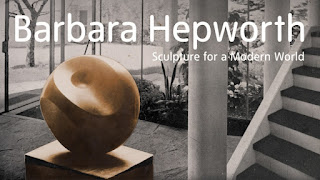Let's begin at the Tate Britain, Millbank, a short walk from the Pimlico Tube Station, where an homage to one of England's most famous sculptors opened in early June. Dame Barbara Hepworth (1903-1975) devoted her life to carving wood and stone beginning in the 1920s and continuing until she perished in a fire at her home in Cornwall.
A native of Yorkshire, Hepworth is primarily known for her work in St. Ives where she had lived since 1939 and consequently assimilated the landscape and culture into her work. Though her earliest pieces were figurative in nature, her ethos became more and more abstract as she explored the theories of her European colleagues, such as Jean Arp and Constantine Brancusi, and
fellow Brits, like Henry Moore and Ben Nicholson whom she married in 1938.
Barbara Hepworth was an early practitioner of the avant garde practise of "Direct Carving" preferring to work directly on the material to be sculpted without using preliminary models for an artisan to follow. By avoiding a third party, i.e. the technician, the resulting piece is an even more intimate expression of the artist's intent and in Hepworth's case, the relationship between nature and people.
As well as being a thoughtful and intelligent artist, Hepworth was also a shrewd promoter. She knew exactly how she wanted her work to be seen and maintained complete control over its presentation and publicity. I came away from this exhibition not only far more aware of her contribution to modern sculpture but very impressed by her marketing skills as well.
A short and scenic ride on the Tate Boat takes us along the Thames from the Tate Britain to the Tate Modern. Here we have two more special exhibitions, both dedicated to 20th century woman artists.
The first is the continuation of an exhibition that I saw in Paris and blogged about last November (see "Delaunay & Delaunay - Robert & Sonia Reign Over Paris") so I will not explore this version too deeply. However, I did spend a very rewarding half and hour revisiting the show and was very impressed with the Tate Modern's presentation.
This is the first UK retrospective of the work of Sonia Delaunay (1885-1979) and the curators gave equal weight to her contributions to both the fine arts and her more commercial endeavors in the decorative arts. From her early paintings and book illustrations to her hugely successful textile and fashion designs to her impressive panels for the 1937 Paris Exhibition, the exhibition explored all facets of this Modernist artist and very modern woman.
I have saved the best for last. Also on view at the Tate Modern is a major retrospective of the American abstract artist Agnes Martin (1912-2004). I was vaguely familiar with the œuvre of Martin having been intrigued by her large, square canvas' with their delicate pencil lines at major art fairs over the years, but I didn't know much about her.
Meticulously crafted and very distinctive, I had always found Agnes Martin's works quite beautiful in their simplicity but I wasn't entirely sure that there was enough there to sustain a solo museum exhibition. But after about a minute in the first room I was hooked and with each gallery became more and more entranced with her technique and her vision.
Agnes Martin was born in Saskatchewan, Canada, but moved to the United States as a teenager. Much like her fellow artist Georgia O'Keeffe, Martin first worked as a school teacher, then spent some time in New York painting with fellow abstract expressionists Mark Rothko, Ellsworth Kelly and Barnett Newman before settling in Taos, New Mexico. A closet homosexual, Martin also suffered from schizophrenia and used the discipline of painting and the regularity of the stripes and pencil lines to keep her grounded.
The rectilinear grids we see repeated over and over in various combinations and against different colored backgrounds are mesmerizing - almost Zen in their tranquility. At first glance the groups of paintings seemed identical but with a second look there were distinct differences and after a little more time each work was truly unique.
The Tate's survey of the paintings, drawings and prints of Agnes Martin was outstanding and a far more powerful experience than I had anticipated. Stripes and lines were never so fascinating!
"Happy Holiday", 1999
Oil and graphite on canvas





No comments:
Post a Comment